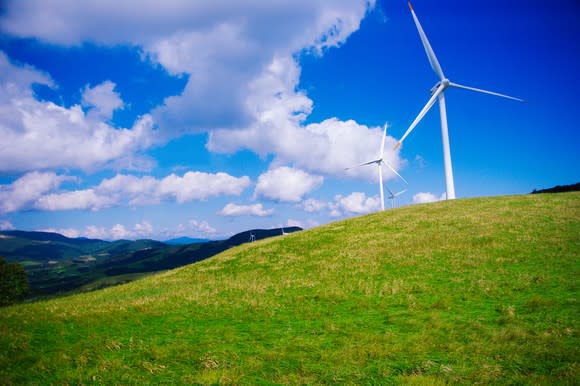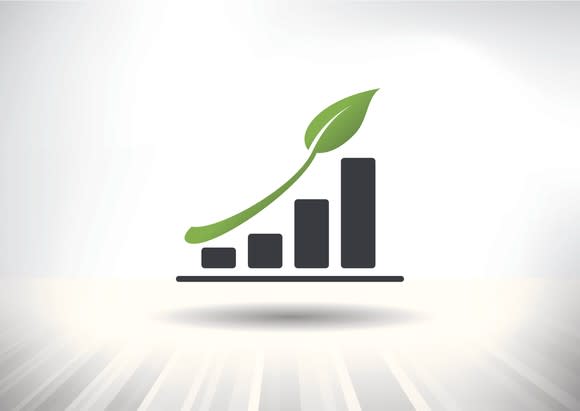3 Top Green Stocks to Consider Buying Now
Humanity is on pace to add billions of people to the ranks of the global middle class by the end of the 21st century. To do so without wrecking the planet, we'll need to become much more efficient at generating energy and extracting resources and more conscious of our impact on the environment, which provides society with trillions of dollars in value that's often overlooked.
While there are many things we can do to limit our footprint, one important activity is rarely considered to go hand in hand with environmental stewardship: investing. If you're looking to help the planet and build wealth, then you should consider buying top green stocks such as leading renewable utility NextEra Energy (NYSE: NEE), solar powerhouse First Solar (NASDAQ: FSLR), and leading renewable chemicals manufacturer Braskem (NYSE: BAK).

Image source: Getty Images.
Low-carbon utility
In 2000, the United States generated 6 billion kWh of electricity from wind. By 2016, that figure had grown to 226 billion kWh, with the renewable energy source accounting for an astonishing 6% of American electricity generation. That required over $150 billion in investment -- and NextEra Energy quietly led the way.
North America's leading renewable utility has invested over $23.6 billion in wind energy assets over the years and now owns about 13,852 MW of generation capacity, which represents 16% of the total installed wind capacity in the U.S. The next closest company owns less than half that.
NextEra Energy is planning to replicate that success in solar energy. In 2016, it produced more solar energy than any other company on the planet and currently owns about 2,262 MW of solar capacity, which represents 11% of America's total.
The company will continue to grow its wind and solar footprint over the years, and why not? NextEra Energy's formidable business (also aided by natural gas and nuclear capacity) generates $16.5 billion in revenue and over $6.3 billion in operating cash flow per year, allowing it to pay shareholders a dividend yielding 2.6%. Combine that with the fact that shares have posted gains in eight of the last nine calendar years and this is easily a top green stock.

Image source: Getty Images.
Solar leader that's ready to run
A squeaky-clean balance sheet has gone a long way for First Solar in the last several years or so, but it's about to go a lot further. Emerging from an industrywide rut and supply chain correction, the company booked 6.7 GW of global solar panel sales in 2017 -- equivalent to one-third of all installed capacity in the United States in 2016 -- and will unload up to 5.7 GW of that by the end of 2020. It's almost sold out of production for the next two years, but don't be surprised if it piles up additional wins in the meantime.
How has the company achieved such incredible success in sales agreements? While it doesn't have the most efficient solar panels in the industry, its technology strategy has largely paid off to date. That's because First Solar relies on thin-film materials, rather than the crystalline silicon panels deployed in over 70% of America's installed capacity. The panels have been a huge hit with commercial-scale solar farms due to several advantages, including cost and performance in certain conditions.
The current market advantage has allowed First Solar to post consistent profits and build an enviable balance sheet that held $2.7 billion in cash and short-term investments at the end of September 2017. That would be a pretty comfortable cushion against market volatility, but the solar industry is on the cusp of a golden age thanks to years of falling costs and rising panel-efficiency ratings.
In the long run, thin-film panels will likely lose out to their crystalline silicon counterparts in cost and efficiency, but that day is still far away. That means this is a top green stock to consider buying right now.

Image source: Getty Images.
The world's largest renewable chemical company
Brazil hasn't been the most stable place to park your hard-earned cash in recent years, but Braskem is worth consideration for any portfolio. The nation's leading chemical manufacturer and the world's largest renewable chemical company has made tremendous progress paying down debt and boosting margins since 2015. Surprisingly, it hasn't sacrificed growth investments along the way.
Braskem is quietly building a leading investment portfolio in synthetic biology, which it hopes to leverage with industrial biotech platforms that utilize genetically engineered microbes to churn out renewable chemicals at commercial scale. That includes a major partnership with bioprocess and scale-up leader Genomatica to produce butadiene in one step (the petrochemical route requires two steps) and an research and development program with Amyris to produce isoprene (rubber).
These production technologies remain a long way off, but the company's novel process for converting ethanol to ethylene will allow it to retain its ranking atop the global leaderboard. Braskem developed the process in-house and built a 200,000-metric-ton-per-year facility in Brazil. Production sold out before construction even began, largely because customers can claim to use renewable ethylene in their plastics. The benefits of the green process: every metric ton of green ethylene reduces atmospheric CO2 by 2.5 metric tons.
Even if the economics for ethylene lean toward petrochemical sources in the years ahead thanks to cheap natural gas in America, Braskem will do just fine -- most of its business resides in petrochemical manufacturing. Besides, the $10 billion company is consistently profitable, growing revenue at a healthy clip for the foreseeable future from new production plant start-ups, and oozes with cash flow (when not paying fines for political scandals).
Growth in multiple industries, coupled with an annual dividend yield averaging over 5% in the last five years, promises to make the company's pioneering efforts in renewable chemicals production pay off in time.
More From The Motley Fool
Maxx Chatsko has no position in any of the stocks mentioned. The Motley Fool recommends First Solar. The Motley Fool has a disclosure policy.

 Yahoo Finance
Yahoo Finance 